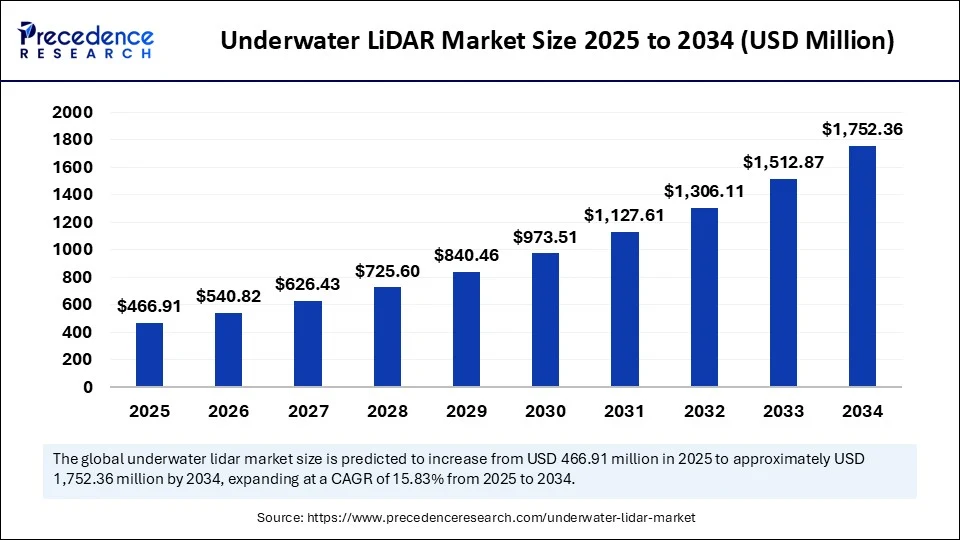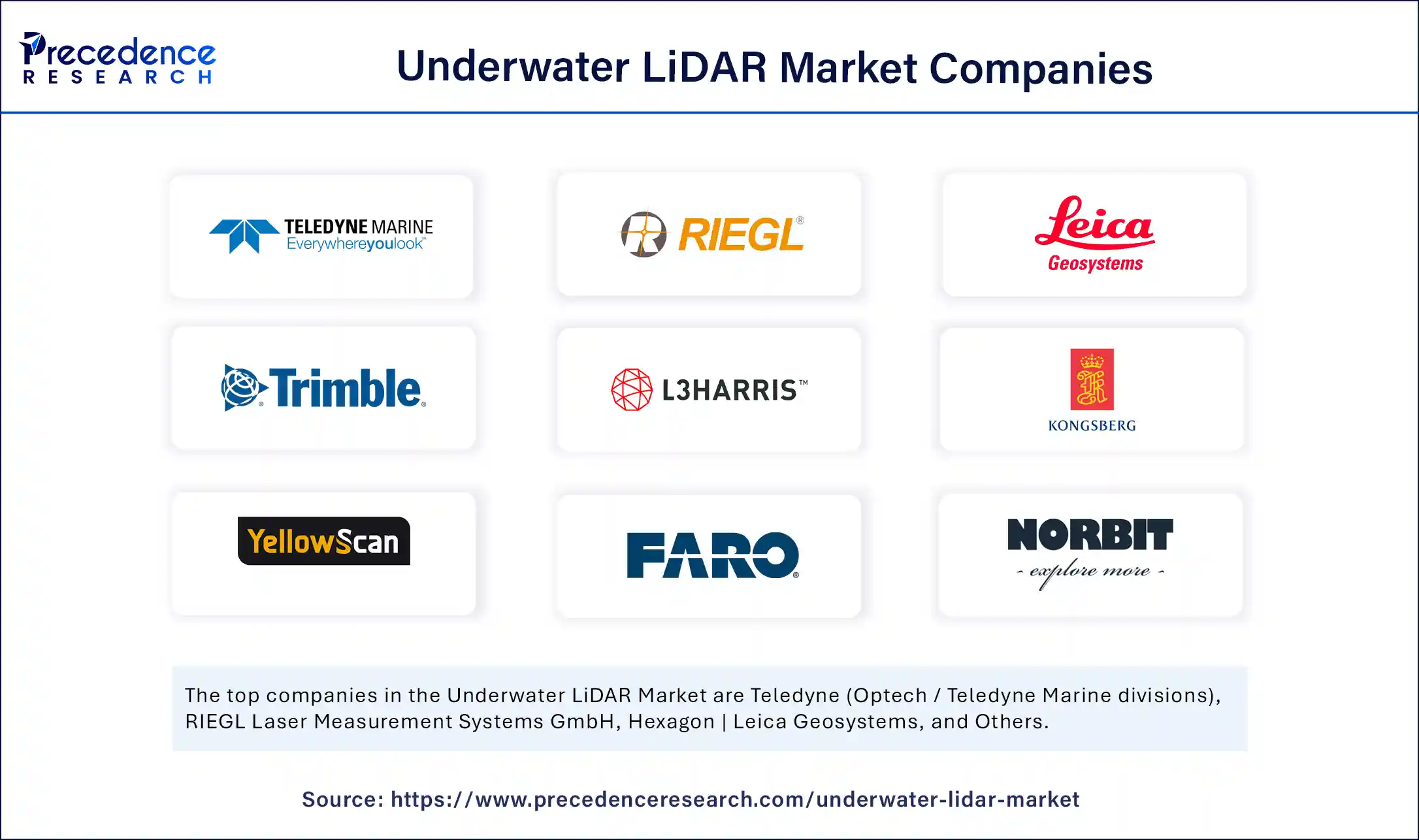The Underwater LiDAR market is forecasted to reach a market valuation of USD 1,752.36 million by 2034, up from USD 466.91 million in 2025. This represents a compound annual growth rate (CAGR) of 15.83% over the forecast period from 2025 to 2034. The market’s robust growth is driven by the increasing demand for precise underwater mapping and surveying technologies across marine research, offshore energy, defense, and environmental monitoring sectors.

Underwater LiDAR Market Key Drivers
-
Increasing Need for Accurate Seabed Mapping: The growth in hydrographic surveys and underwater topography projects, especially related to offshore wind farm installations and marine construction, fuels the demand.
-
Expansion of Offshore Renewable Energy: Particularly offshore wind farms require detailed seabed mapping for turbine placement, cable routing, and environmental impact assessments.
-
Government and Defense Investments: Government agencies prioritize maritime security and safe navigation, investing heavily in underwater mapping solutions.
-
Environmental and Marine Conservation Efforts: Scientists and environmentalists use these technologies for coral reef monitoring, marine habitat assessments, and climate resilience projects.
-
Technological Innovations: Improvements in LiDAR system capabilities, affordability, and integration with autonomous platforms facilitate broader adoption.
Get this report to explore global market size, share, CAGR, and trends, featuring detailed segmental analysis and an insightful competitive landscape overview @ https://www.precedenceresearch.com/sample/6683
Underwater LiDAR Market Key Insights
-
The market’s value is projected to grow from approximately USD 403.1 million in 2024 to USD 1.75 billion by 2034.
-
North America currently leads the market in revenue share.
-
The Asia Pacific region is the fastest-growing, driven by increased maritime security initiatives and technological adoption.
-
Bathymetric LiDAR systems are the top-sellers owing to their precision and reliability in shallow and coastal waters.
-
Airborne platforms represent the largest market segment, while UAV/drone-mounted LiDAR systems are experiencing the fastest growth.
-
The leading end-use application is hydrographic surveying, followed by offshore wind farm surveys expanding rapidly.
-
Industry leaders include defense organizations, research institutions, and commercial suppliers developing cutting-edge LiDAR systems.
Role of Artificial Intelligence in Underwater LiDAR
Artificial Intelligence (AI) enhances underwater LiDAR functionality primarily by streamlining data processing, reducing manual intervention, and increasing overall accuracy. AI-powered algorithms efficiently handle large datasets from underwater surveys, automate feature classification, and detect seabed anomalies or marine life. This accelerates mapping projects and improves operational decisions.
Furthermore, integrating AI with autonomous underwater vehicles (AUVs) or drones enables real-time underwater data collection without constant human oversight. The combination boosts mission efficiency in offshore construction, defense surveillance, and environmental monitoring using advanced signal filtering techniques that mitigate turbidity-induced noise.
Underwater LiDAR Market Segmentation Analysis
-
By System Type: Bathymetric LiDAR dominates by market share because of high accuracy and suitability for oceanographic and coastal applications.
-
By Platform: Airborne LiDAR has the largest share due to its utility in extensive marine surveys; drones/UAVs lead in growth because of cost-effectiveness and adaptability in nearshore and shallow waters.
-
By Components: Laser transmitters and AI-enhanced receivers are gaining traction for enhanced penetration depth and clearer signals.
-
By Application: Hydrographic surveying emerges as the largest segment; offshore wind farms and submarine cable route surveys are quickly growing.
-
By Water Type: Clear coastal waters dominate usage; however, turbid water applications rise as system capabilities improve.
Latest Breakthroughs
Key innovations include the development of AI-powered autonomous platforms integrated with LiDAR for enhanced real-time underwater surveys. Leading companies and research institutions are advancing hybrid systems combining bathymetric and terrestrial data collection, improving laser transmission modules, and deploying UAV/drone-mounted sensors.
Underwater LiDAR Market Companies

- Teledyne (Optech / Teledyne Marine divisions)
- RIEGL Laser Measurement Systems GmbH
- Hexagon | Leica Geosystems
- Trimble Inc.
- L3Harris Technologies
- Kongsberg Maritime
- YellowScan
- Faro Technologies
- Norbit ASA
- Valeport Ltd.
- Teledyne CARIS (hardware partnerships within the Teledyne group)
- CGG (marine sensing hardware group)
- Aerodyne Group (bathymetric LiDAR integrations)
- R2Sonic (sonar/LiDAR integrated OEMs)
- Aerialtronics / UAV LiDAR OEMs (integrated bathy solutions)
- GeoAcoustics / subsea sensor OEMs (integrated platforms)
- Optech-qualified system integrators (OEM-branded bathy systems)
- BlueView (Teledyne BlueView branded sensors)
- Scantech (industrial LiDAR OEMs offering marine variants)
- Sentek (marine sensor OEMs with LiDAR modules)
Market Challenges and Cost Pressures
-
High acquisition and operational costs hinder widespread adoption, especially for smaller enterprises.
-
Environmental factors such as water turbidity, depth limits, and corrosive conditions pose technical challenges.
-
Maintenance of underwater systems requires specialized skills and rigorous upkeep.
-
Regulatory and security concerns around underwater mapping create compliance hurdles.
-
Limited availability of trained personnel in operating sophisticated LiDAR systems.
Case Study: Offshore Wind Farm Survey
In offshore wind farm development, underwater LiDAR technology was pivotal for seabed mapping and cable routing. The high-resolution data enabled precise turbine placement and ecological impact assessments, mitigating risk and enhancing project timelines. AI-assisted analytics streamlined data interpretation, underscoring the technology’s significant role in renewable energy infrastructure.
Read Also: Simulator Windows and Simulator Skylight Market
You can place an order or ask any questions. Please feel free to contact us at sales@precedenceresearch.com |+1 804 441 9344